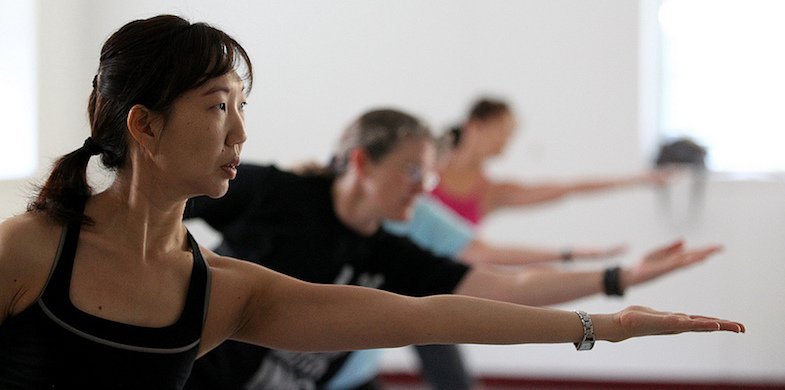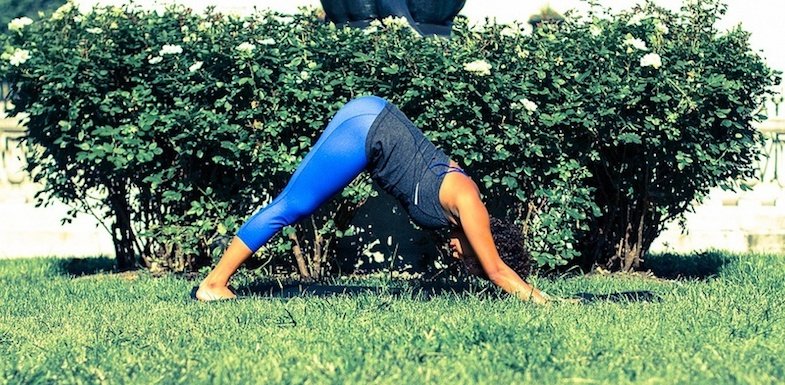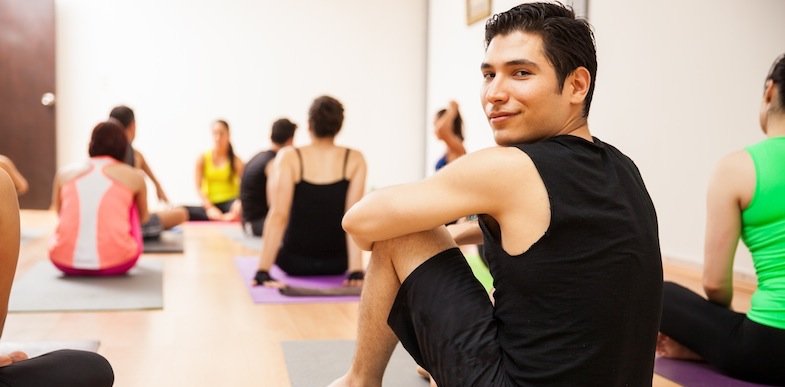If you suffer from the pain of arthritis, you know how important it is to find holistic options for relieving pain and stiffness. Thankfully, yoga for arthritis is a gentle option that incorporates joint-freeing poses with mindfulness meditation. Here’s how to get started with easy yoga for arthritis, including a full at-home sequence.
What is easy yoga for arthritis so important?
There are over 100 different kinds of arthritis, and arthritis is a common cause of chronic pain. The two most common types of arthritis are:
- Osteoarthritis: A wear-and-tear condition that occurs when years of use of a joint wears down the cartilage and results in painful bone-on-bone rubbing. This type is generally seen in people over 55.
- Rheumatoid arthritis: This type of arthritis is an autoimmune response that triggers painful swelling and inflammation in the joints. People of any age can be affected by rheumatoid arthritis.
One in five adults over the age of 55 will experience some form of arthritis in their lifetime, potentially so severe as to make daily life and tasks difficult if not impossible. Doctors continue to recommend exercise as a primary treatment for many types of arthritis, but for some patients, fear of more pain or injuring the joint further may prevent them from actually starting to exercise.
While the idea of moving a swollen, painful joint may seem impossible, there is new evidence that yoga for arthritis can improve joint function, decrease pain, and improve mood.
What is the research on yoga for arthritis?
Over the years, Johns Hopkins professor Dr. Clifton O. Bingham III has witnessed many of his arthritis patients’ lives transform through the practice of yoga. However, there wasn’t much data on whether the practice was safe, especially considering how taxing some of the poses may be on the joints. Intrigued, Bingham teamed up with his colleagues to complete what they believe is the largest trial yet examining not only the practice’s pain-reliving abilities, but also its safety.
The randomized trial of 75 patients with knee osteoarthritis and rheumatoid arthritis found that yoga students in the group had a 20% increase in energy level, mood, and ability to function, along with decreased levels of pain. Perhaps the best news out of this study is that yoga for arthritis is not only effective, but it is also safe and easy to implement at any stage of arthritis, from mild discomfort to severe pain.
Designing the study was a collaboration between yoga therapists specifically trained in yoga for arthritis, doctors, and researchers. They focused on easy yoga for arthritis poses and postures. This resulted in a checklist that researchers designed for doctors to share with their patients. Bingham believes that alleviating concerns and going slowly to start are keys to success, saying:
“[Arthritis patients should] talk with their doctors about which specific joints are of concern, and about modifications to poses. Find a teacher who asks the right questions about limitations and works closely with you as an individual. Start with gentle yoga classes. Practice acceptance of where you are and what your body can do on any given day.”
The study is important because although experts say exercise is one of the best things a person can do to manage arthritis, up to 90% of patients don’t move enough, researchers say.
Tips before you start easy yoga for arthritis
Yoga is a unique physical exercise in that classes can be extremely gentle and restorative or exceptionally physically challenging, making even the most elite athlete sweat. Because students’ abilities and experiences with the practice vary so much, here are some tips for arthritis patients wanting to try a class. Here’s how to get started reaping the benefits of yoga for arthritis.
Talk with your doctor
As suggested in the study above, it is important to discuss your options with your doctor before beginning any new exercise program. Your doctor may have recommendations, or they may offer specific guidelines or tips for exercise. Ask if there are any poses or movements to avoid. This will vary depending on the specific type of arthritis you have.
Seek out a yoga studio
Because the benefits of yoga on physical and mental wellness are becoming more well-known, there are now over 50,000 yoga studios in the U.S. In addition, many community centers and gyms may offer a weekly class or two.
When choosing a studio, look for the following classes:
- Easy yoga for arthritis: There are classes specifically designed for those who have arthritis, and these are a great place to start if you are unsure and feel like you need more support as you begin. Modifications are plentiful, and instructors will also help you use props to easily get up from the floor (and back down for savasana!).
- Gentle yoga: These classes are generally the same as a “regular” yoga class but may be paced a bit more slowly to offer plenty of time for modifications. This may be a good option if you have a class or two of experience or if your arthritis is mild.
- Therapeutic yoga: Therapeutic yoga focuses strongly on alignment and strength-building. It will be important to let your teacher know that about your arthritis before you begin so that he can offer modifications or help you prop your pose.
- Beginner yoga: Stick with beginner classes to start, and ask the studio if they have teachers who have additional training in yoga for arthritis.
Find a teacher and a class
The Yoga Alliance is an organization that licenses yoga teachers. Although no states require a yoga teacher to hold a specific license, a Yoga Alliance certification can help you to find a teacher that has undergone specific training. Use their search tool to find a teacher near you.
Seek out gentle or beginner classes with a teacher who is knowledgeable about modifications for poses. Tell the teacher before class about your condition, and don’t hesitate to ask for modifications to poses. There are always alternative ways of accessing the posture.
Use your body as a guide. Yoga should never hurt. You may feel discomfort, but you should never feel any sharp pain, particularly in the joint. If you do, back out of the pose a little bit or ask the teacher to help you find an alternate pose.
Try at-home yoga for arthritis
With just a little bit of research, you can begin your yoga journey at home. A special “joint freeing” series can help you get started, especially if you are nervous, uncertain, or self-conscious about beginning.
These exercises start seated on the floor and include:
- Pointing and flexing the feet
- Circling ankles in both directions to improve joint mobility
- Gentle stretching exercises that work the hamstrings and calves and help engage the abdomen
Other exercises include cat/cow poses (arching like a cat and then dropping the belly to wake up the spine), gentle seated twists, gentle strengthening exercises, and slow, steady breathing. The entire series can be completed in a chair if needed. Completing the series just once a week improves mobility, mood, and strength, but for best results, try to spend at least 20 minutes a day practicing yoga.
An easy yoga for arthritis sequence
Here is a gentle set of yoga exercises known as the joint freeing series that you can practice at home. Follow this sequence, repeating each movement at least seven times. Stay mindful of the physical sensations you experience, only doing as much as you can.
Legs
Start with your legs extended straight in front of you, spine long and perpendicular to the floor.
- Exhale, flex the feet and inhale, point the feet. Repeat.
- Connect the feet, big toes touching, and exhale, flip the feet, connecting the soles. Inhale, return the feet to neutral and repeat. Keep the legs straight.
- Rotate the feet, exercising the ankles, seven times in each direction.
- Bend the right leg, placing the sole of the foot flat on the floor and keeping the left leg straight. Clasp your hands behind the right calf. Inhale, extend the right leg straight and exhale, bend the leg and return the foot to the floor. Repeat seven times, and then continue on the other side.
- Separate the legs into a V-shape, keeping the spine long. Inhale, rotate the right leg outward, sending the pinky toe toward the ground, and swing the leg right. Then, rotate the right leg inward, sending the big toe toward the floor. Exhale and swing the leg toward center. Repeat seven times, and continue on the other side.
Cat/cow
Next, come into all fours, wrists under shoulders and knees under hips. Press firmly into the hands, fingers wide and weight evenly distributed.
- Inhale, lift the pelvis up and tilt the heart forward, exhale, arch the spine. Continue this motion seven times.
- Inhale, extending the right leg straight behind you. Exhale, bring the knee toward the forehead, slightly rounding the back. Repeat both sides seven times.
- Rock the hips from side to side.
Seated twist
Finally, go into a seated position, cross-legged if possible or on a chair.
- Extend your arms parallel to the floor in front of you. Inhale, send the fingers toward the floor, bending the wrists. Exhale, flexing the wrists.
- Inhale flip the wrists so the palms face the sky. Exhale, turn the hands over so the palms face the floor. Repeat seven times.
- Rotate wrists counterclockwise and then clockwise.
- Inhale, extend arms straight in front of you, palms up. Exhale, bend the elbows, bringing hands to shoulders. Inhale, straighten, and repeat.
- Bring the hands to the shoulders. Inhale, open the arms out to the side, and exhale, connect the elbows at center.
- Extend your arms out to the side, parallel to the floor. Then, bend the elbows and face palms toward the wall in front of you. Exhale, rotate the arms, sending the palms down to the wall behind you. Inhale, bring the palms back up to the starting position.
- Inhale, reach the arms straight overhead. Exhale, lower them down and send them behind your back. Repeat.
- Arch the back and squeeze the shoulder blades together. Exhale, round the back forward.
- Exhale, place your left hand next to you on the floor and gently bend to left. Inhale center and repeat both sides.
- Inhale, sit up tall and exhale, twist to the left, keeping the back long. As you continue to inhale, come back to center, and twist right. Repeat.
- Inhale, send the head gently back, only as far as feels comfortable for you. Exhale, lower chin to chest.
- Exhale, let the head fall gently to the right, stretching the neck. Inhale, bring the head back to center and stretch to the left. Repeat.
- Exhale, look to the right, gently twisting the neck. Inhale center and look to the left. Repeat.
Get started
What other tips do you have for easy yoga for arthritis? Incorporating this practice into your pain management plan can lead to profound pain relief.
However, if you’ve tried yoga and other holistic options and haven’t found relief, contact us today for more specialized help for managing your pain.


